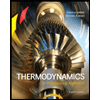
The expressions for the ratio of the stagnation pressure after a shock wave to the static pressure before the shock wave as a function of
Answer to Problem 121RP
The expressions for the ratio of the stagnation pressure after a shock wave to the static pressure before the shock wave as a function of
Explanation of Solution
Write the Equation 17-38 as in text book (the relation between the pressures after shock and before shock for an ideal gases).
Here, the specific heat ratio is
Write the relation between the stagnation pressure
Here, the subscript 0 indicates the stagnation state.
Write the Equation 17-39 as in text book (the expression for Mach number after shock).
Conclusion:
Rearrange the Equation (I) to obtain
Express the Equation (II) for state 2 i.e. after shock.
Substitute
Refer Equation (III).
Substitute
Thus, the expressions for the ratio of the stagnation pressure after a shock wave to the static pressure before the shock wave as a function of
Want to see more full solutions like this?
Chapter 17 Solutions
Thermodynamics: An Engineering Approach
- An ideal isentropic nozzle is attached to an infinite reservoir that has stagnation conditions 3 MPa and 2250 K, and a constant specific heat of 1.2. If the nozzle's static exit pressure is 38.871 kPa, what is the exit static temperature? Also determine the nozzle's exit Mach number, stagnation pressure, and stagnation temperature.arrow_forwardAir flowing steadily in a nozzle experiences a normal shock at a Mach number of Ma = 2.6. If the pressure and temperature of air are 58 kPa and 270 K, respectively, upstream of the shock, calculate the pressure, temperature velocity, Mach number, and stagnation pressure downstream of the shock. Calculate the entropy changes of air and helium across the normal shock wavearrow_forwardMach number at a certain section in a diverging part of a c-d nozzle is 0.7. At farther section (towards the exit), Mach number reduces to 0.4. Hence, the cross-sectional area of the farther section is greater byarrow_forward
- Consider air entering a heated duct at p1 = 1 atm and T1 = 288 K. Ignore the effect of friction. Calculate the amount of heat per unit mass (in joules per kilogram) necessary to choke the flow at the exit of the duct for an inlet Mach number of M1 = 2.2.arrow_forwardNitrogen enters a converging–diverging nozzle at 620 kPa and 310 K with a negligible velocity, and it experiences a normal shock at a location where the Mach number is Ma = 3.0. Calculate the pressure, temperature, velocity, Mach number, and stagnation pressure downstream of the shock. Compare these results to those of air undergoing a normal shock at the same conditions.arrow_forwardAir flowing steadily in a nozzle experiences a normal shock at a Mach number of Ma = 2.6. If the pressure and temperature of air are 58 kPa and 270 K, respectively, upstream of the shock, calculate the pressure, temperature, velocity, Mach number, and stagnation pressure downstream of the shock. Compare these results to those for helium undergoing a normal shock under the same conditions.arrow_forward
- For a given Prandtl-Meyer expansion, the upstream Mach number is 3 and the pressure ratio across the wave is p,/p, = 0.4. Calculate the angles of the forward and rearward Mach lines of the expansion fan relative to the free-stream direction.arrow_forwardA flow of air with Mach number M1 = 2, pressure p1 = 0.7 atm, and temperature 630 degR is turned away from itself through an angle of 26.38 deg. Determine the Mach number, the staticpressure, the static temperature, and the stagnation pressure after the turn (all pressures in atm).Also determine the Mach angles at the beginning and end of the expansion fan.arrow_forwardA subsonic airplane is flying at a 5000-m altitude where the atmospheric conditions are 54 kPa and 256 K. A Pitot static probe measures the difference between the static and stagnation pressures to be 16 kPa. Calculate the speed of the airplane and the flight Mach number.arrow_forward
- The pressure upstream of a normal shock wave is 1 atm. The pressure and temperature downstream of the wave are 10.33 atm and 1,390 °R, respectively. Calculate the Mach number and temperature upstream of the wave.arrow_forwardConsider a point in an airflow where the local Mach number, static pressure, and static temperature are 2.5, 0.3 atm, and 180 K, respectively. Calculate the local values of P0, T0, T ∗, a∗, and M∗ at this pointarrow_forwardRace cars at the Indianapolis Speedway average speeds of185 mi/h. After determining the altitude of Indianapolis,fi nd the Mach number of these cars and estimate whethercompressibility might affect their aerodynamics.arrow_forward
 Elements Of ElectromagneticsMechanical EngineeringISBN:9780190698614Author:Sadiku, Matthew N. O.Publisher:Oxford University Press
Elements Of ElectromagneticsMechanical EngineeringISBN:9780190698614Author:Sadiku, Matthew N. O.Publisher:Oxford University Press Mechanics of Materials (10th Edition)Mechanical EngineeringISBN:9780134319650Author:Russell C. HibbelerPublisher:PEARSON
Mechanics of Materials (10th Edition)Mechanical EngineeringISBN:9780134319650Author:Russell C. HibbelerPublisher:PEARSON Thermodynamics: An Engineering ApproachMechanical EngineeringISBN:9781259822674Author:Yunus A. Cengel Dr., Michael A. BolesPublisher:McGraw-Hill Education
Thermodynamics: An Engineering ApproachMechanical EngineeringISBN:9781259822674Author:Yunus A. Cengel Dr., Michael A. BolesPublisher:McGraw-Hill Education Control Systems EngineeringMechanical EngineeringISBN:9781118170519Author:Norman S. NisePublisher:WILEY
Control Systems EngineeringMechanical EngineeringISBN:9781118170519Author:Norman S. NisePublisher:WILEY Mechanics of Materials (MindTap Course List)Mechanical EngineeringISBN:9781337093347Author:Barry J. Goodno, James M. GerePublisher:Cengage Learning
Mechanics of Materials (MindTap Course List)Mechanical EngineeringISBN:9781337093347Author:Barry J. Goodno, James M. GerePublisher:Cengage Learning Engineering Mechanics: StaticsMechanical EngineeringISBN:9781118807330Author:James L. Meriam, L. G. Kraige, J. N. BoltonPublisher:WILEY
Engineering Mechanics: StaticsMechanical EngineeringISBN:9781118807330Author:James L. Meriam, L. G. Kraige, J. N. BoltonPublisher:WILEY





